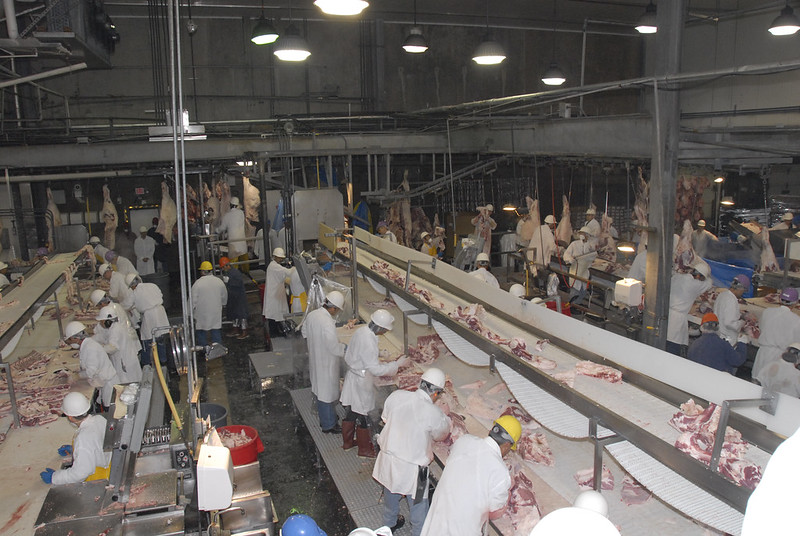
In the early weeks of the pandemic, it became clear that meatpacking workers would bear a heavy burden, along with other frontline workers. In the meatpacking and food processing plant sector, nearly 92,000 workers have tested positive for COVID-19 and 466 workers have died from COVID-19, as of September 2021. Available data show that workers of color account for 80% of confirmed cases in an industry in which people of color comprise 80% of the workforce.
In a recent article in Sociological Perspectives, we drew on case studies of meatpacking facilities in three Midwestern states to analyze how industry consolidation and the hiring of marginalized workers affected worker safety and food system stability during the pandemic. We find that the meatpacking industry’s hyper-concentration and exploitative labor strategies created precarious structural conditions which COVID-19 deepened, producing two inter-connected processes:
- a precarity convergence which passed the growing risk of the pandemic on to workers, amplifying systemic vulnerability and
- the transformation of the worksite into a sacrifice zone, an area destroyed in the name of profit accumulation.
We argue that these outcomes were made possible by three intersecting dynamics: the perception that workers were expendable, the “otherization” of workers, and state-backed power.
Worker expendability
Since the 1970s, meatpacking companies have increasingly recruited workers with little bargaining power. While the industry previously relied on urban, unionized workers, companies relocated to rural areas to be closer to production and to lower labor and regulatory costs. These jobs had high turnover rates, due to dangerous work conditions and low pay. Because meatpacking companies needed an unending stream of workers willing to acquiesce to such conditions, they quickly ran through the supply of local workers and began to recruit more marginalized labor, particularly Black, immigrant, and refugee workers.
COVID heightened dangerous work conditions within meatpacking, further contributing to workers’ perceived disposability. Managers forced employees to finish shifts while awaiting COVID-19 test results, whereas managers in Iowa made betting pools on how many workers would die of COVID-19. One immigrant worker, asked before dying, “They brought me back, for what? For me to die there?”
“Otherization” of workers
Fifty-one percent of meatpacking and food processing plant workers are foreign-born. In the United States, a nation rife with racism and nativism, workers are often the target of vitriol. Former Congressman Steve King, whose district relied on meatpacking activities, routinely disparaged Muslim refugee workers. In a Kansas meatpacking region, journalists called for a return of the eugenicist 1924 Immigration Act.
This long-running “otherization” of meatpacking workers established a playbook for government and industry leaders to use in response to COVID-19. For instance, a Wisconsin Supreme Court Justice invalidated the governor’s stay-at-home orders saying that the outbreak did not count because “These were due to meatpacking… It wasn’t the regular folks in Brown County” (emphasis added). Other elected officials blamed the outbreak in meatpacking on the poor cultural habits and behavior of immigrants. Such comments illustrate that people in positions of power frequently “otherized” meatpacking workers prior to COVID-19, and after the viral outbreak merely repurposed prejudices to prioritize profit accumulation over worker health and safety.
State-backed power
Government has played a central role in allowing the meatpacking industry to cultivate structural precarity. One key way was through the state’s facilitation of industry consolidation over the last few decades. Today, a handful of meatpacking firms control much of the industry. The state provided subsidies and support that enabled this consolidation, while largely ignoring anti-trust laws. The federal government has steadily weakened worksite enforcement at meatpacking plants by allowing line speeds to increase and by decreasing the number of worksite inspectors.
When COVID-19 hit, the federal government classified meatpacking plants as critical infrastructure, denied access to welfare programs, and cut off options for workers to address worksite grievances. One worker recounted: “A coworker vomited on the line and management let him continue to work… There are eight people working in front of me and another 10 or more behind me… I am scared I will die because of work, but I need to work to buy food for my family.” By limiting alternatives for workers to stay safe at home to flatten the curve, industry, together with government, created structural conditions that coerced workers into remaining in a potentially fatal worksite.
Addressing precarious labor
Our article advances the study of precarity in essential worksites, highlighting how environmental injustices and worker characteristics are intertwined, and importantly, how workplace vulnerability engenders systemic vulnerability. Change will not come easy, but the spotlight the pandemic has shown on essential worksites is difficult to ignore. COVID-19 has brought demands for better oversight, labor “shortages”, and promises for increased anti-trust protections. These demands, together with recent government challenges to industry power, hold promise for beginning to address the marked precarity in essential worksites.
Read more
Ian Carrillo and Annabel Ipsen. “Worksites as Sacrifice Zones: Structural Precarity and COVID-19 in U.S. Meatpacking.” Sociological Perspectives 2021.
image: U.S. Department of Agriculture via Flickr

No Comments